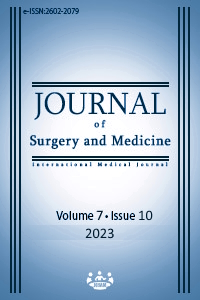The role of CYP2C9 gene polymorphism in rheumatoid arthritis
CYP2C9 polymorphism in rheumatoid arthritis
Keywords:
CYP2C9, polymorphism, rheumatoid arthritisAbstract
Background/Aim: The inflammatory disorder rheumatoid arthritis (RA) affects quality of life and worsens with symptoms in the extra-articular tissues and systemic joints. The most significant member of the Cytochrome P450 enzyme family, Cytochrome P450 2C9 (CYP2C9), plays an essential role in the alkylation, demethylation, and hydroxylation of a variety of substances. Insufficient studies as to whether the susceptibility to rheumatoid arthritis is genetic exists. Therefore, our study presents new information on whether CYPC9 is a genetic risk factor. In this study, we sought to determine whether rheumatoid arthritis and the CYP2C9 gene polymorphism are related.
Methods: This study was conducted as a prospective case-control study. Fifty patients with RA and 50 healthy individuals were included in our study group. Blood from the controls and patients was drawn into ethylenediaminetetraacetic acid (EDTA)-containing tubes, and using a DNA isolation kit, DNA was isolated from leukocytes. Reverse transcriptase polymerase chain reaction (RT-PCR) was used to assess the genotypes of CYPC9*2 and CYP2C9*3 with the LightCycler-CYP2C9 mutation detection kit.
Results: The heterozygous CYP2C9*2 genotype was found to carry a 2.85-fold risk when compared with the controls (odds ratio [OR]=2.85, 95% confidence interval [CI]: 0.52–15.50; P=0.22); however, this risk was not statistically significant. It was found that people with the CYP2C9*3 heterozygous genotype had a statistically significant 2.79-fold higher risk compared to the controls (OR=2.79, 95% CI: 1.13–7.00 P=0.04).
Conclusion: The heterozygous genotype of CYP2C9*3 may contribute to the onset of RA.
Downloads
References
Sparks JA. Rheumatoid Arthritis. Ann Intern Med. 2019;170(1):ITC1-ITC16. doi: 10.7326/AITC201901010. DOI: https://doi.org/10.7326/AITC201901010
Fraenkel L, Bathon JM, England BR, St Clair EW, Arayssi T, Carandang K, et al. American College of Rheumatology Guideline for the Treatment of Rheumatoid Arthritis. Arthritis Care Res (Hoboken). 2021;73(7):924-39. doi: 10.1002/acr.24596. DOI: https://doi.org/10.1002/acr.24596
Croia C, Bursi R, Sutera D, Petrelli F, Alunno A, Puxeddu I. One year in review 2019: pathogenesis of rheumatoid arthritis. Clin Exp Rheumatol. 2019;37(3):347-57. PMID: 31111823.
Van Doornum S, Brand C, King B, Sundararajan V. Increased case fatality rates following a first acute cardiovascular event in patients with rheumatoid arthritis. Arthritis Rheum. 2006;54:2061-8. doi: 10.1002/art.21932 DOI: https://doi.org/10.1002/art.21932
Sánchez-Maldonado JM, Cáliz R, Canet L, Horst RT, Bakker O, den Broeder AA, et al. Steroid hormone-related polymorphisms associate with the development of bone erosions in rheumatoid arthritis and help to predict disease progression: Results from the REPAIR consortium. Sci Rep. 2019;9(1):14812. doi: 10.1038/s41598-019-51255-0. DOI: https://doi.org/10.1038/s41598-019-51255-0
Waring RH. Cytochrome P450: genotype to phenotype. Xenobiotica. 2020;20(1):9-18. doi: 10.1080/00498254.2019. DOI: https://doi.org/10.1080/00498254.2019.1648911
Sangkuhl K, Claudio-Campos K, Cavallari LH, Agundez JAG, Whirl-Carrillo M, Duconge J, et al. PharmVar GeneFocus: CYP2C9.Clin Pharmacol Ther. 2021;110(3):662-76. doi: 10.1002/cpt.2333 DOI: https://doi.org/10.1002/cpt.2333
Mizutani T. PM frequencies of major CYPs in Asians and Caucasians. Drug Metab Rev. 2003;35:99–106. doi: 10.1081/dmr-120023681 DOI: https://doi.org/10.1081/DMR-120023681
Chen Y, Goldstein JA. The transcriptional regulation of the human CYP2C genes. Curr Drug Metab. 2009;10(6):567-78. doi: 10.2174/138920009789375397 DOI: https://doi.org/10.2174/138920009789375397
Wysocki T, Olesińska M, Paradowska-Gorycka A. Current Understanding of an Emerging Role of HLA-DRB1 Gene in Rheumatoid Arthritis-From Research to Clinical Practice. Cells. 2020;2;9(5):1127. doi: 10.3390/cells9051127 DOI: https://doi.org/10.3390/cells9051127
Smallwood MJ, Nissim A, Knight AR, Whiteman M, Haigh R, Winyard PG. Oxidative stress in autoimmune rheumatic diseases Free Radic Biol Med. 2018;125:3-14. doi: 10.1016/j.freeradbiomed.2018.05.086. DOI: https://doi.org/10.1016/j.freeradbiomed.2018.05.086
Phull AR, Nasir B, Haq IU, Kim SJ. Oxidative stress, consequences and ROS mediated cellular signaling in rheumatoid arthritis. Chem Biol Interact. 2018;1;281:121-36. doi: 10.1016/j.cbi.2017.12.024 DOI: https://doi.org/10.1016/j.cbi.2017.12.024
Hoxha M, Zappacosta B. CYP-derived eicosanoids: Implications for rheumatoid arthritis. Prostaglandins Other Lipid Mediat. 2020;146:106405. doi: 10.1016/j.prostaglandins.2019.106405 DOI: https://doi.org/10.1016/j.prostaglandins.2019.106405
Blake DR, Merry P, Unsworth J, Kidd BI, Outhwaite JM, Ballard R. Hypoxia reperfusion injury in the inflamed human joint. Lancet. 1989;i:289–93. doi: 10.1016/s0140-6736(89)91305-6. DOI: https://doi.org/10.1016/S0140-6736(89)91305-6
Layton MA, Jones PW, Alldersea JE, Strange RC, Fryer AA, Dawes PT, Mattey DL. The therapeutic response to D-penicillamine in rheumatoid arthritis: influence of glutathione S-transferase polymorphisms. Rheumatology (Oxford). 1999;38(1):43-7. doi: 10.1093/rheumatology/38.1.43 DOI: https://doi.org/10.1093/rheumatology/38.1.43
Von Schmiedeberg S, Fritsche E, Ro¨nnau AC, Specker C, Golka K, Richter-Hintz D, Schuppe HC, Lehmann P, Ruzicka T, Esser C, Abel J, Gleichmann E. Polymorphisms of the xenobiotic-metabolizing enzymes CYP1A1 and NAT-2 in systemic sclerosis and lupus erythematosus. Adv Exp Med Biol. 1999;455:147. doi: 10.1007/978-1-4615-4857-721. DOI: https://doi.org/10.1007/978-1-4615-4857-7_21
Daly AK. Molecular basis of polymorphic drug metabolism. J Mol Med. 1995;73:539. doi: 10.2165/00003088-200645010-00002 DOI: https://doi.org/10.1007/BF00195139
Halliwell B. Oxygen radicals, nitric oxide and human inflammatory joint disease. Ann Rheum Dis. 1995;54:505-10. doi: 10.1136/ard.54.6.505 DOI: https://doi.org/10.1136/ard.54.6.505
Guengerich FP, Shimada T. Oxidation of toxic and carcinogenic chemicals by human cytochrome P-450 enzymes. Chem Res Toxicol. 2005;4:391-407. doi: 10.1021/tx00022a001 DOI: https://doi.org/10.1021/tx00022a001
Morinobu S, Morinobu A, Kanagawa S, Hayashi N, Nishimura K, Kumagai S. Glutathione S-transferase M1, T1, and P1 genotypes in Japanese patients with rheumatoid arthritis. J Rheumatol. 2006;24(3):268-73. PMID: 16870093
Yen JH, Chen CJ, Tsai WC, Lin CH, Ou TT, Hu CJ, Liu HW. Manganese Superoxide Dismutase and Cytochrome P450 1A1 Genes Polymorphisms in Rheumatoid Arthritis in Taiwan. Hum Immunol. 2003;64(3):366-73. doi: 10.1016/s0198-8859(02)00818-2. DOI: https://doi.org/10.1016/S0198-8859(02)00818-2
Pawlik A, Ostanek L, Brzosko I, Gawroska-Szklarz B, Brzosko M, Dabrowska-Zamojcin E. Increased genotype frequency of N-acetyltransferase 2 slow acetylation in patients with rheumatoid arthritis. Clin Pharmacol Ther. 2002;72(3):319-25. 10.1067/mcp.2002.126740 DOI: https://doi.org/10.1067/mcp.2002.126740
Van Booven D, Marsh S, McLeod H, Carrillo MW, Sangkuhl K, Klein TE, et al. Sitokrom P450 2C9-CYP2C9. Pharmacogenet Genomics. 2010;20(4):277-81. doi: 10.1097/FPC.0b013e3283349e84. DOI: https://doi.org/10.1097/FPC.0b013e3283349e84
Downloads
- 571 625
Published
Issue
Section
How to Cite
License
Copyright (c) 2023 Hatice Yıldırım Yaroğlu , Ali Biçer
This work is licensed under a Creative Commons Attribution-NonCommercial-NoDerivatives 4.0 International License.
















